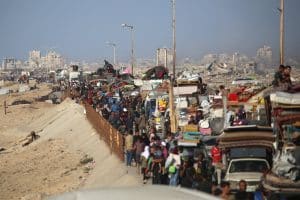PNN – Former British Prime Minister Tony Blair’s new plan for the future of the Gaza Strip proposes the formation of an international authority with the aim of disarming the resistance and taking over the management of the region for an indefinite period.
According to the report of Pakistan News Network, Tony Blair’s proposed plan for the future of the Gaza Strip unveils a detailed roadmap for replacing the current governance structure with an international trusteeship under Western management.
This plan, which is being developed with the possible support of the US government, focuses primarily on the complete disarmament of Gaza and the establishment of a new administrative-security structure that will give the West unlimited control of Gaza, by making conditional promises to the PA.
As Israel faces challenges on the ground in the Gaza Strip to achieve its declared war goals, political efforts behind the scenes to plan the “day after” have accelerated. Meanwhile, the plan developed by former British Prime Minister Tony Blair, with the green light of circles close to US President Donald Trump, has received more attention than other options. The plan, which is currently being finalized with the collaboration of figures such as Jared Kushner and Steve Whitakoff, presents a complex roadmap for managing Gaza, underlying which are the long-term security goals of the West and Israel.
The most central part of the plan, which serves as a tool to garner regional and international support, is the promise of the eventual handover of Gaza administration to the Palestinian Authority.
However, an examination of the terms and implementation mechanisms shows that this promise is more of a distant goal and a means to legitimize a long and uncertain transition period. In fact, the intended transition period is likely to be extended indefinitely under the pretext of unpreparedness.
GITA Structure: Multi-layered Control Tool
The main thrust of Blair’s plan is the establishment of an “International Transitional Authority for Gaza.” This body, to be established by a UN Security Council resolution, would have a complex, multi-layered management structure:
- International Board of Directors: This board will be the highest decision-making body and will consist of representatives from Western countries (led by the US), moderate Arab countries (such as Saudi Arabia, the UAE and Egypt), and possibly representatives from international institutions. This composition will ensure the dominance of the Western perspective in major decisions.
- Palestinian Executive Authority (PEA): A technocratic body of “non-political” and “independent” Palestinians will be formed to run the day-to-day and technical affairs of Gaza. This structure effectively bypasses the PA government based in Ramallah and creates a parallel bureaucracy that is directly accountable to the international authority, not to the Palestinian political leadership.
- International Stabilization Force (ISF): This multinational military force will be responsible for ensuring internal security in Gaza. The force’s stated priority is to completely disarm Hamas and other resistance groups, destroy tunnels, and prevent the reemergence of any Palestinian military capability. It will effectively be Israel’s executive arm to achieve a goal it has failed to achieve on the battlefield.
- Retreat from forced population transfer: One of the most important points of this plan compared to previous ones is the lack of reference to racist plans such as the forced transfer of the Gaza population and their expulsion from this strip. Not only is the plan not a population relocation program, but it even envisions the creation of a “Property Rights Preservation Unit.” The unit’s goal is to ensure that any potential voluntary departure by Gaza residents does not undermine their right to return to the area or their right to retain ownership of their property. An informed source involved in the discussions surrounding Blair’s plan told The Times of Israel bluntly: We have no plans to move the population of Gaza out of Gaza. Gaza is for the Gazans. Although these claims cannot yet be trusted, it seems that the resistance of the Gazans and international criticism of previous plans have led to this at least nominal withdrawal.
Transitional period; unlimited control mechanism

Blair’s plan is based on the concept of a “transition period” at the end of which sovereignty would be transferred to a “reformed” self-governing entity. But the mechanisms defined effectively turn this process into a lever of pressure:
The condition of “reforms” and decision-making authority: The transfer of control of Gaza to the PA is conditional on significant reforms in the areas of security, finance, and governance. More importantly, the definition of these reforms, their assessment of progress, and their final approval will be the responsibility of the board of directors of the international authority and its Western backers. This structure allows the West to extend the transitional period indefinitely, citing the “inadequacy of reforms,” especially in the security sector, and force the self-governing organization to fully accept its dictates.
Marginalization of the current structure of the Self-Government Organization: During the transitional period, the Self-Government Organization will not have a direct governing role. Its role will be reduced to that of an “observer” or “coordinator” who must await approval of its performance by international institutions before it can regain its authority. This process places the PA in a paradox: to retake Gaza, it must sacrifice its legitimacy and independence.
Repeating the experience of the Oslo process: This model has a strong structural similarity to the Oslo process, which was supposed to be a five-year transition period but resulted in more than three decades of fruitless negotiations and the continuation of the status quo. Blair’s plan, by defining a “transition period” without a specific time limit, has the potential to turn into a permanent international trusteeship over Gaza, effectively institutionalizing the political and administrative separation of Gaza from the West Bank.
Strategic challenges and goals
The plan faces serious challenges. Israeli Prime Minister Benjamin Netanyahu opposes any role for the Palestinian Authority in Gaza. On the other hand, Arab countries such as Saudi Arabia have made their financial support conditional on the existence of an “irreversible path to the establishment of a Palestinian state,” something that Blair’s plan does not guarantee.
However, the designers’ strategic goals are quite clear:
- International legitimization: Using the name of the PA and the promise of forming a Palestinian state is a cover to gain the approval of the international community and regional actors so that this plan is not considered a colonial project. In fact, Arab and international opposition to previous plans, in which the PA, as an institution internationally responsible for the Palestinian territories, was not given any role, has led to this organization being given a minimal role in this plan, and a hypothetical distant horizon for returning to Gaza has been given, in order to eliminate both the organization’s opposition and international opposition.
- Returning to the logic of the mandate era: The second dark point of this plan is that it intends to make a non-Palestinian entity responsible for Palestinian affairs. This should be interpreted as a return to the logic of the colonial era and the mandate systems, because no timetable is foreseen in the Blair plan.
- Funding from Arab sources: This promise is designed to persuade Arab countries to fund the reconstruction and administration of Gaza (where the annual budget of GITA alone is estimated at hundreds of millions of dollars) with the prospect of contributing to “Palestinian unity.”
- Stabilizing Israel’s security: The ultimate goal of the plan is to create a security buffer zone with management that guarantees Israel’s long-term security interests and removes political and military pressure from Tel Aviv.
Tony Blair’s plan for the future of Gaza is, on the surface, a roadmap for reconstruction and a peaceful transfer of power to the Palestinian Authority, but in essence, it is a complex strategy to impose international guardianship and ensure Israel’s long-term security. The plan would effectively hand over full security, political, and administrative control of Gaza to a Western-led coalition for an indefinite period by creating an institution called the International Transitional Authority. The main goal of this structure is to completely disarm resistance groups and prevent the reemergence of any Palestinian military power, a goal that Israel has failed to achieve on the battlefield.

